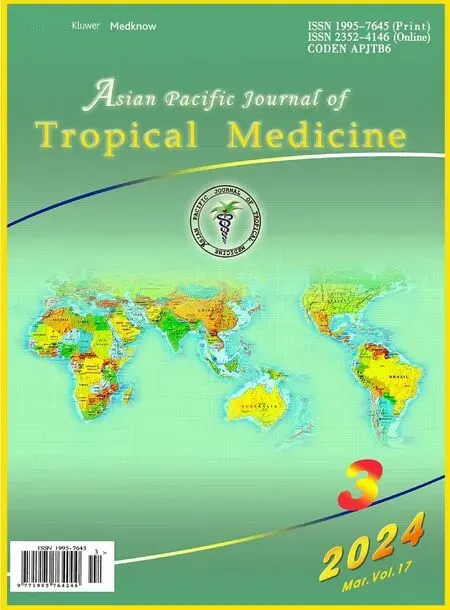Navigating the future of malaria control: Insights from India's pioneering malaria slide bank
Sheikh Mohd Saleem ,Shah Sumaya Jan
1Public Health Expert,Health Section,International Non-Government Organisation,New Delhi,India
2Department of Anatomy,Government.Medical College,Srinagar,India
We applaud the authors for their illuminating perspective on India's malaria slide bank (MSB),featured in the recent publication in your esteemed journal[1].The article provides a comprehensive overview of the establishment,challenges,and future potential of MSBs,offering valuable insights into the complexities and opportunities inherent in this critical asset for India's malaria elimination program.The perpective discusses the following captivating aspects:
1) Thorough protocols and quality control: The perspective rightly emphasizes the meticulous protocols followed in the establishment of the MSB at ICMR-National Institute of Malaria Research.The inclusion of DNA extraction and PCR analysis for species confirmation underscores the commitment to precision in malaria diagnosis.
2) Challenges highlighted: The candid discussion on challenges associated with MSB development,including resource limitations and technical complexities,is praiseworthy.This transparent approach underscores the need for sustained investment and commitment to ensure the effectiveness of MSBs.
3) Training and competency assessment: The authors aptly explore the role of MSBs in training malaria microscopists,contributing to national competency assessments and refresher programs.The integration of artificial intelligence (AI) and digital systems in malaria reporting is a forward-looking approach that can significantly enhance the efficiency of laboratory technicians.
4) Potential applications post-malaria elimination: The discussion on the potential applications of MSBs post-malaria elimination demonstrates foresight and a commitment to the long-term impact of this initiative.The authors rightly address the challenges associated with maintaining expertise and infrastructure as malaria cases decrease.
However,there are some provocative avenues for further exploration as mentioned below:
1) Socio-economic impact: Delving deeper into the socioeconomic impact of MSB implementation would be valuable.Exploring its effects on local communities,potential job creation,and opportunities for skill development could provide a more comprehensive understanding of the broader implications of MSBs[2].
2) International collaborations: Expanding on potential collaborations with international organizations and neighboring countries could strengthen the cross-border accessibility of MSB resources.Investigating partnerships that foster a more integrated approach to malaria control efforts in the region and contribute to a global perspective on combating malaria would be insightful[3].
3) Public awareness and education: Discussing strategies for raising public awareness about the significance of MSBs and the role they play in malaria control could enhance the overall impact of these initiatives.Educating the public about malaria prevention and diagnosis through MSBs could contribute to community engagement and support[4].
4) Technological advancements: Considering the rapid pace of technological advancements,exploring how emerging technologies could further enhance the functionality and reach of MSBs would be beneficial.This could include discussions on potential collaborations with tech companies and the integration of cutting-edge tools for more efficient malaria diagnosis[5].
While the perspective admirably explores the various facets of India's MSB,delving deeper into the socio-economic impact,fostering international collaborations,enhancing public awareness,and embracing technological advancements would undoubtedly enrich the narrative.We are grateful for the opportunity to contribute these considerations and eagerly anticipate the continued exchange of insightful perspectives.
Conflict of interest statement
The authors declare that there are no conflicts of interest.
Funding
The authors received no extramural funding for the study.
Authors’ contributions
SMS conceptualized and designed the study and drafted the initial manuscript.SSJ contributed to the study design,data analysis,and critically reviewed and revised the manuscript for important intellectual content.Both authors approved the final manuscript as submitted and agreed to be accountable for all aspects of the work.
Publisher’s note
The Publisher of theJournalremains neutral with regard to jurisdictional claims in published maps and institutional affiliations.
 Asian Pacific Journal of Tropical Medicine2024年3期
Asian Pacific Journal of Tropical Medicine2024年3期
- Asian Pacific Journal of Tropical Medicine的其它文章
- Smoking of Carica papaya in Nigeria: The rationale,the public health effects and policies for intervention
- Mitigating fire risks in hospitals: Are we primed and geared up?
- Advances in Zika virus vaccines and therapeutics: A systematic review
- Epidemic management in a measles outbreak in 2023,the return of vaccinepreventable diseases: A single center,retrospective observational study
- Prevalence and risk factors associated with long COVID symptoms in children and adolescents in a southern province of Vietnam
- Characteristics of hospitalized patients with confirmed COVID-19 and their hospital management
